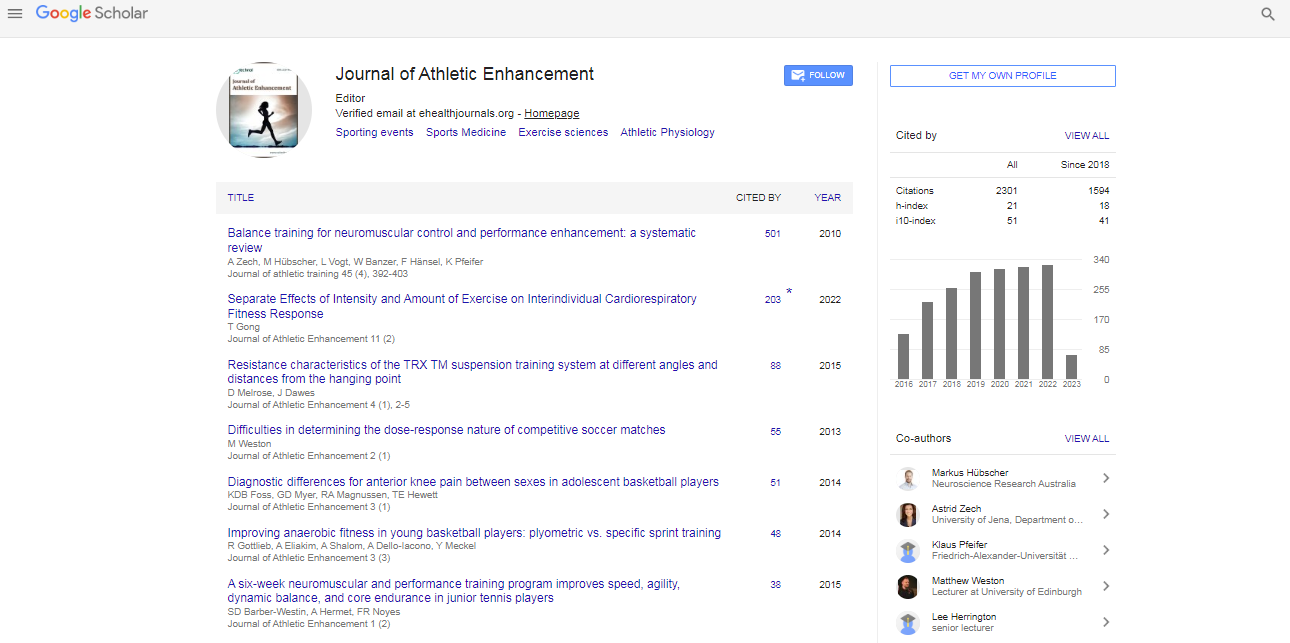Perspective, J Athl Enhanc Vol: 13 Issue: 6
Physiotherapy: A Comprehensive Approach to Healing and Rehabilitation
Chen Zhenya*
1Department of Sports, China Pharmaceutical University, Nanjing, China
*Corresponding Author: Chen Zhenya,
Department of Sports, China Pharmaceutical
University, Nanjing, China
E-mail: zhenya787@edu.cn
Received date: 28 October, 2024, Manuscript No. JAE-24-153772;
Editor assigned date: 31 October, 2024, PreQC No. JAE-24-153772 (PQ);
Reviewed date: 14 November, 2024, QC No. JAE-24-153772;
Revised date: 21 November, 2024, Manuscript No. JAE-24-153772 (R);
Published date: 28 November, 2024 DOI: 10.4172/2324-9080.1000160
Citation: Zhenya C (2024) Physiotherapy: A Comprehensive Approach to Healing and Rehabilitation. J Athl Enhanc 13:6.
Description
Physiotherapy, also known as physical therapy, is a medical field dedicated to the rehabilitation, prevention and management of physical impairments and disabilities. It involves the assessment, diagnosis, treatment and prevention of movement disorders or injuries caused by illness, surgery, or aging. Physiotherapists are healthcare professionals who employ a variety of techniques, including exercises, manual therapy and education, to restore function, reduce pain and improve the overall quality of life of their patients. The goal of physiotherapy is not only to alleviate symptoms but to address the root causes of physical dysfunction, helping individuals regain independence and lead a more active life.
The scope of physiotherapy extends to individuals of all ages, from new-borns to the elderly. It is commonly sought by people recovering from surgeries, accidents, strokes, or injuries, as well as those suffering from chronic conditions such as arthritis, respiratory disorders and neurological conditions. Physiotherapists use a combination of treatments such as therapeutic exercises, manual techniques, electrotherapy and patient education to tailor individualized care plans based on a person’s needs and goals. These interventions aim to strengthen muscles, improve flexibility, restore joint function and enhance coordination.
One of the fundamental aspects of physiotherapy is its emphasis on movement. Since the human body is designed to move, the loss of mobility or functionality can have significant physical and emotional impacts. Physiotherapists assess movement patterns, postural alignment and muscle strength to identify areas of dysfunction. This comprehensive assessment allows them to design customized rehabilitation programs aimed at restoring optimal function and preventing further injury. The treatments may vary depending on the condition, but they often include strengthening exercises, balance training, stretching and functional retraining.
Manual therapy, which involves hands-on techniques such as joint mobilizations, soft tissue manipulation and massage, is another important component of physiotherapy. These manual techniques are used to improve range of motion, reduce muscle tension, alleviate pain and enhance circulation. Manual therapy can be particularly effective for patients suffering from musculoskeletal conditions like back pain, neck pain, or joint stiffness. Physiotherapists often integrate manual therapy with other therapeutic modalities to maximize the benefits of treatment.
Electrotherapy is another tool commonly employed by physiotherapists. It involves the use of electrical modalities such as ultrasound, Transcutaneous Electrical Nerve Stimulation (TENS), and interferential therapy to treat pain and promote tissue healing. Ultrasound therapy, for example, uses sound waves to generate heat within tissues, stimulating blood flow and encouraging the repair of injured muscles, tendons and ligaments. TENS and interferential therapy, on the other hand, use electrical currents to reduce pain by stimulating nerve fibers and releasing endorphins, the body’s natural pain-relieving substances.
In conclusion, physiotherapy is an important healthcare discipline that plays an important role in promoting physical well-being and improving quality of life. By focusing on movement, rehabilitation and prevention, physiotherapists help patients of all ages recover from injuries, manage chronic conditions and prevent future health issues. The holistic, non-invasive nature of physiotherapy makes it an effective, long-term solution for many individuals seeking to maintain or restore their physical function. Whether it’s recovering from surgery, managing a chronic condition, or preventing injury, physiotherapy offers a comprehensive approach to healing that empowers patients to take charge of their health and well-being.
 Spanish
Spanish  Chinese
Chinese  Russian
Russian  German
German  French
French  Japanese
Japanese  Portuguese
Portuguese  Hindi
Hindi 
